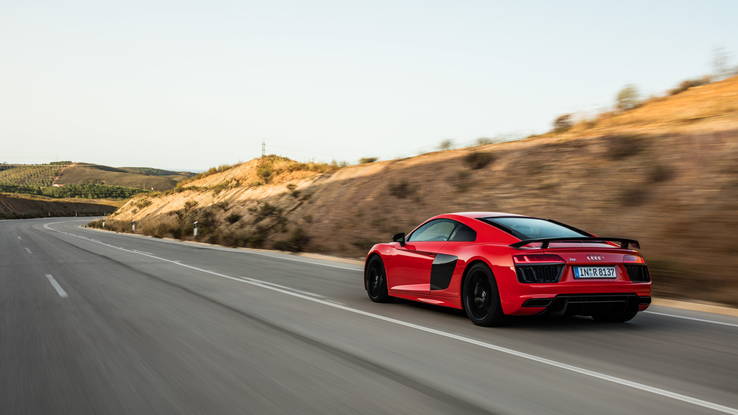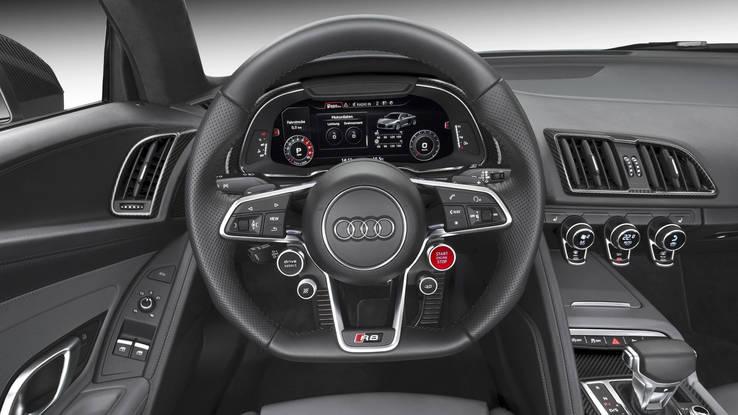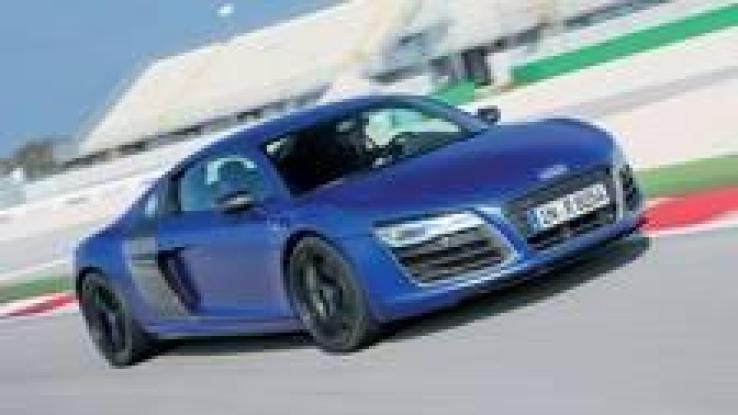Audi’s fastest road car ever is surprisingly simple to pilot
“What the hell is everyone looking at? Oh, right.” That was the thought we kept coming back to, bombing across the back roads of Portugal in the new Audi R8 V10 Plus, headed stateside next spring. After a few hours in the cockpit, it just felt like a regular Audi. But, of course, it wasn’t. With 610 hp, it’s the fastest road-going car the company has ever produced. It even has more power than the factory-produced customer race car, according to Audi, with which it shares about 50 percent of its parts.
Audi kept the design formula of the original R8, only gently revising the front and rear to be sharper and more aggressive. The new TT and A4 follow the same language. The fenders are a bit wider, and the company changed its sideblade design to two pieces instead of one. The overall shape, which apes the Le Mans car in profile, is basically unchanged. The V10 Plus gets a carbon-fiber spoiler; the standard V10 has a flush, body-color piece that deploys at speed. Exterior, sideblade and interior colors can all be customized through the Audi Exclusive program. The automaker displayed a slate-gray model with orange trim — we’ll confess to liking it more than the standard hues we drove, which already got a lot of love from all the walkers and bikers along our route.
The naturally aspirated 5.2-liter V10 in the Plus raises the game 60 hp over the last model and 15 lb-ft more torque for a new total of 413 lb-ft, all available at 6,500 rpm. The screaming German powerplant only finally cuts out at a stratospheric 8,700 rpm. The R8 can sprint to 62 mph in 3.2 seconds, reaching 124 mph in 9.9. Top speed is 205 mph, which seemed reachable when paddling through the gears. The “base” V10 — Audi says no V8s are planned as of now — gets 540 hp and 398 lb-ft.

The R8 V10 Plus felt supremely composed over the bumpy Portuguese roads.
What’s it like to drive?
Power is fed to all four wheels through a seven-speed S-tronic dual-clutch transmission, which swapped cogs seamlessly and instantaneously. Shift times? We estimate 0.0 seconds. The company hasn’t decided if it will add the sweet, gated manual transmission of the last generation. We’re keeping our hopes up. The V10 sings loudly at speed, but not in the Italian-Ferrari-opera sort of way. It sounds more clinical, more synthesized, more tuned. Gear changes and early liftoffs are greeted with a satisfying pop-pop from the dual exhaust.
Audi says the central diff can send 100 percent of the power forward or backward, something you can feel when you purposely get it out of shape when the traction control is in performance mode or off. A little wheel correction combined with the front rubber pulling had us back in line in no time.
On the smooth Portuguese roads, the R8 felt as composed as a supercar can, which is to say it rode a lot like a really fast Audi sedan. Double wishbones at each corner kept everything planted, while the optional 20-inch Pirellis hung on for dear life. The chassis seemed impervious to bad and bumpy pavement during braking, turning and acceleration. Even around unfamiliar, decreasing radius turns, it just absorbed the undulations and kept rocketing toward the horizon. As with the last generation, the R8 gets the Drive Mode Select function, which adjusts the steering, suspension, throttle and shift parameters from comfort to auto to dynamic. Performance, which is a new mode, is accessed through a checkered-flag button on the steering wheel and dials back the traction control threshold.

The wheel features full controls for everything but climate.
About that wheel. Audi went full manettino with the new R8, putting all the relevant functions within a finger length. The big red start button is to the right, along with the exhaust “loud” button. Drive Select, navigation and, most importantly, the performance button are on the left. Behind the wheel is Audi’s new Virtual Cockpit, a 12.3-inch configurable screen showing speed, revs, maps, radio and other important info. Audi leveraged Google Earth for its nav system, meaning not only could we see the address we were going to, we could see the color of the building. And, on an unfamiliar racetrack, we’d be lying if we said we didn’t look down for a split second to remember if this downhill was a left or a right.
We found the standard shell seats perfectly comfortable for everyday driving, even after a hundred or so miles behind the wheel. Audi will also offer a full-leather package, which is a little softer on the behind. Neither seat has a height adjustment, but the headliner is high enough to fit a driver with a helmet or an exceptionally tall German.
With the Virtual Cockpit behind the wheel, the central dash is free of clutter save for a few vents and knobs for the climate control. The company also moved the jog dial aft of the shifter, so one doesn’t have to reach around to use the functions.
After a few hours on public roads with little fatigue, we hit the rising and running 2.9-mile Algarve International Circuit for some full-speed laps. Here we had a chance to throw the R8 around a little and found it as easy as the last model to drive fast. It’s possibly the easiest supercar to pilot that we’ve ever tested. Mechanical grip is strong and confidence inspiring, only letting go when we got back on the gas too early in exiting a sharp corner. A quick loosening of the reins brought the car back in line quickly; that was in performance mode. We had plenty of fun with the traction control completely on, too. Through the roller coaster-style hills, the car only felt light for a split second at the peak and was easily pulled back down with a tap on the optional carbon-ceramic brakes. We didn’t feel any fade at the track, but we only did a few laps at a time; a full 20-minute session might tell a different story. The R8 V10 and V10 Plus both feature launch control, which is just a matter of putting the car in performance mode, standing on the brake and then standing on the throttle. It doesn’t feel nearly as harsh on the car as it does some other vehicles. Cough, Nissan GT-R, cough.

2014 Audi R8 V10 Plus review notes
ASSOCIATE EDITOR JAKE LINGEMAN: I haven’t driven an R8 for a few years. This V10 Plus with the new dual-clutch gearbox is way more civil than the last model. The transmission is less vicious and much …
Do I want one?
We only tested the European-spec cars, but, according to Audi, there won’t be many changes when they hit dealerships in the U.S. next spring. We won’t get the stop/start system, or the frickin’ laser headlights, which actually look cooler off than on. We do get different side markers but otherwise, very close. The R8 V10 will sticker for 165,000 euros. The V10 Plus will come in at 187,400. Audi says U.S. prices will be revealed closer to launch. For reference, the last V10 Plus was $ 173,500.
Audi does have something special with the R8. That’s why it didn’t stray too far from its successful formula. The company had its first R8 auto-show car on display from 2003 at the event, and it looked like it could have been designed yesterday. Couple that with its stability and comfort on the road and its ease to drive fast on the track, and there’s a lot to like. Just remember, you’re in a supercar, and that’s what the hell everyone is looking at.




























